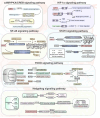The roles of Cryptochrome-1: the circadian clock as a control point in cancer therapy
- PMID: 40528171
- PMCID: PMC12175451
- DOI: 10.1186/s12967-025-06702-0
The roles of Cryptochrome-1: the circadian clock as a control point in cancer therapy
Abstract
In this review, we carefully describe the composition and operation of cryptochrome-1 (CRY1). We introduce four related signaling pathways, namely cAMP/PKA/CREB signaling way, HIFα signaling way, NF-κB signaling way, STAT3 signaling way, FOXO signaling pathway and Hedgehog (HH) signaling pathway. We also emphasize the current understanding of the complex roles CRY1 plays in the progression of various solid tumors. We propose that its function represents a novel therapeutic target that could pave the way for new cancer treatments. Additionally, we summarize three emerging therapeutic strategies based on the roles of CRY1: targeting CRY1 with small molecules, using CRY1 as diagnostic and therapeutic tools, and promoting drug efficacy through CRY1 modulations. It is imperative to underscore the significance of conducting more extensive research to translate the insights obtained from cellular and animal models into practical human applications, ultimately enhancing therapeutic outcomes.
Keywords: CRY1; Cancer; Circadian clock; In Silico; Signaling pathway.
© 2025. The Author(s).
Conflict of interest statement
Declarations. Ethics approval and consent to participate: Not applicable. Consent for publication: Not applicable. Competing interests: The authors declare that they have no competing interests.
Figures


Similar articles
-
M54 selectively stabilizes the circadian clock component of CRY1 and enhances the period of circadian rhythm at cellular level.J Biol Chem. 2025 Jul;301(7):110333. doi: 10.1016/j.jbc.2025.110333. Epub 2025 Jun 4. J Biol Chem. 2025. PMID: 40480635 Free PMC article.
-
Molecular feature-based classification of retroperitoneal liposarcoma: a prospective cohort study.Elife. 2025 May 23;14:RP100887. doi: 10.7554/eLife.100887. Elife. 2025. PMID: 40407808 Free PMC article.
-
Comprehensive pan-cancer analysis reveals NTN1 as an immune infiltrate risk factor and its potential prognostic value in SKCM.Sci Rep. 2025 Jan 25;15(1):3223. doi: 10.1038/s41598-025-85444-x. Sci Rep. 2025. PMID: 39863609 Free PMC article.
-
Assessing the comparative effects of interventions in COPD: a tutorial on network meta-analysis for clinicians.Respir Res. 2024 Dec 21;25(1):438. doi: 10.1186/s12931-024-03056-x. Respir Res. 2024. PMID: 39709425 Free PMC article. Review.
-
Defining disease severity in atopic dermatitis and psoriasis for the application to biomarker research: an interdisciplinary perspective.Br J Dermatol. 2024 Jun 20;191(1):14-23. doi: 10.1093/bjd/ljae080. Br J Dermatol. 2024. PMID: 38419411 Free PMC article. Review.
References
-
- Olejniczak I, Begemann K, Wilhelm I, Oster H. The circadian neurobiology of reward. Acta Physiol. 2023;237(3):e13928. - PubMed
-
- Roenneberg T, Merrow M. Circadian clocks — the fall and rise of physiology. Nat Rev Mol Cell Biol. 2005;6(12):965–71. - PubMed
-
- Ahmad M, Cashmore AR. HY4 gene of A. thaliana encodes a protein with characteristics of a blue-light photoreceptor. Nature. 1993;366(6451):162–6. - PubMed
-
- Partch CL, Sancar A. Photochemistry and photobiology of Cryptochrome Blue-light photopigments: the search for a photocycle. Photochem Photobiol. 2005;81(6):1291–304. - PubMed
Publication types
MeSH terms
Substances
LinkOut - more resources
Full Text Sources
Medical
Miscellaneous

